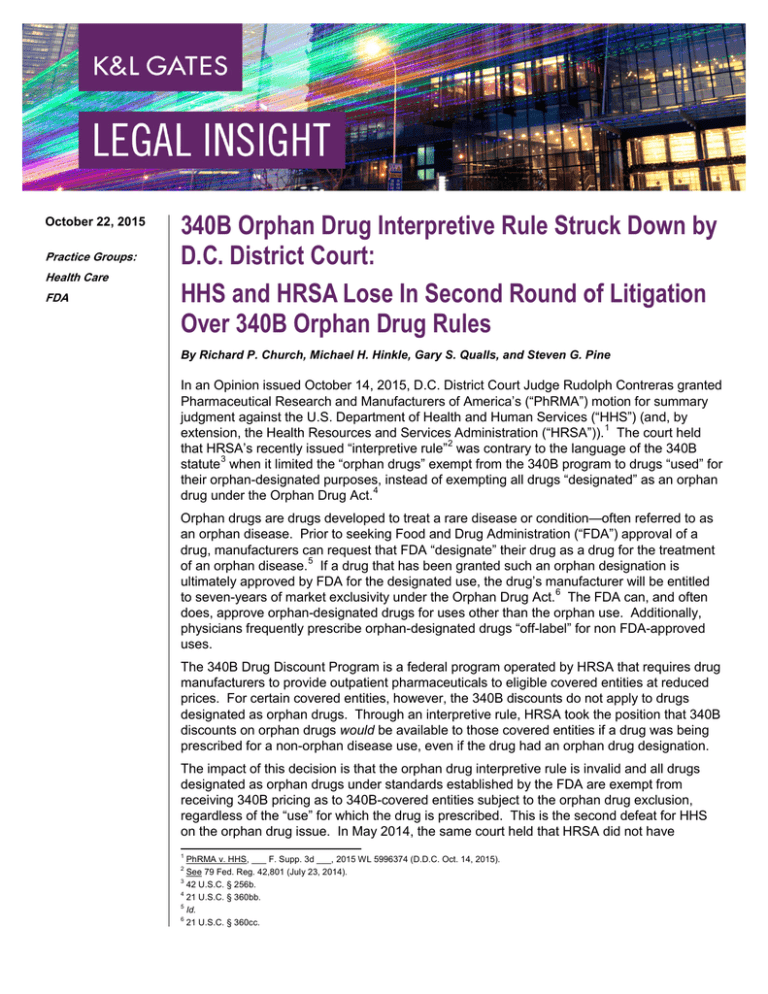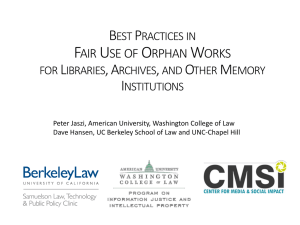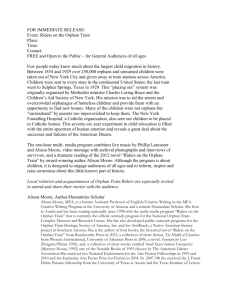
October 22, 2015
Practice Groups:
Health Care
FDA
340B Orphan Drug Interpretive Rule Struck Down by
D.C. District Court:
HHS and HRSA Lose In Second Round of Litigation
Over 340B Orphan Drug Rules
By Richard P. Church, Michael H. Hinkle, Gary S. Qualls, and Steven G. Pine
In an Opinion issued October 14, 2015, D.C. District Court Judge Rudolph Contreras granted
Pharmaceutical Research and Manufacturers of America’s (“PhRMA”) motion for summary
judgment against the U.S. Department of Health and Human Services (“HHS”) (and, by
extension, the Health Resources and Services Administration (“HRSA”)). 1 The court held
that HRSA’s recently issued “interpretive rule”2 was contrary to the language of the 340B
statute 3 when it limited the “orphan drugs” exempt from the 340B program to drugs “used” for
their orphan-designated purposes, instead of exempting all drugs “designated” as an orphan
drug under the Orphan Drug Act. 4
Orphan drugs are drugs developed to treat a rare disease or condition—often referred to as
an orphan disease. Prior to seeking Food and Drug Administration (“FDA”) approval of a
drug, manufacturers can request that FDA “designate” their drug as a drug for the treatment
of an orphan disease. 5 If a drug that has been granted such an orphan designation is
ultimately approved by FDA for the designated use, the drug’s manufacturer will be entitled
to seven-years of market exclusivity under the Orphan Drug Act. 6 The FDA can, and often
does, approve orphan-designated drugs for uses other than the orphan use. Additionally,
physicians frequently prescribe orphan-designated drugs “off-label” for non FDA-approved
uses.
The 340B Drug Discount Program is a federal program operated by HRSA that requires drug
manufacturers to provide outpatient pharmaceuticals to eligible covered entities at reduced
prices. For certain covered entities, however, the 340B discounts do not apply to drugs
designated as orphan drugs. Through an interpretive rule, HRSA took the position that 340B
discounts on orphan drugs would be available to those covered entities if a drug was being
prescribed for a non-orphan disease use, even if the drug had an orphan drug designation.
The impact of this decision is that the orphan drug interpretive rule is invalid and all drugs
designated as orphan drugs under standards established by the FDA are exempt from
receiving 340B pricing as to 340B-covered entities subject to the orphan drug exclusion,
regardless of the “use” for which the drug is prescribed. This is the second defeat for HHS
on the orphan drug issue. In May 2014, the same court held that HRSA did not have
1
PhRMA v. HHS, ___ F. Supp. 3d ___, 2015 WL 5996374 (D.D.C. Oct. 14, 2015).
See 79 Fed. Reg. 42,801 (July 23, 2014).
3
42 U.S.C. § 256b.
4
21 U.S.C. § 360bb.
5
Id.
6
21 U.S.C. § 360cc.
2
340B Orphan Drug Interpretive Rule Struck Down by D.C. District
Court:
HHS and HRSA Lose In Second Round of Litigation Over 340B
Orphan Drug Rules
rulemaking authority to promulgate regulations regarding how the 340B statute applies to
orphan drugs.7 It also comes at a time when HHS has recently proposed a separate 340B
“Mega Guidance,” portions of which may be subject to a similar challenge. 8
Background on Orphan Drug Rule and PhRMA’s Challenge
As part of the Patient Protection and Affordable Care Act (“ACA”), Congress added several
new categories of covered entities to the 340B program: children’s hospitals that are
excluded from the Medicare prospective payment system, free-standing cancer hospitals that
are excluded from the Medicare prospective payment system, critical access hospitals, rural
referral centers, and sole community hospitals.9 However, in the Health Care and Education
Reconciliation Act—which amended the ACA—Congress then excluded from the term
“covered outpatient drug” those drugs “designated by the Secretary under section 526 of the
Federal Food, Drug, and Cosmetic Act for a rare disease or condition” for only the newly
qualifying covered entities above. 10 By further legislative action, Congress then clarified that
children’s hospitals, which previously had been eligible to participate in the 340B program,
were not subject to the orphan drug exclusion. 11
The orphan drug interpretive rule was originally issued as a legislative rule promulgated
under the notice and comment provisions of the federal Administrative Procedure Act
(“APA”). 12 Under both the legislative rule and the interpretive rule, HRSA proposed to
interpret the orphan drug exclusion to only apply to orphan drugs that are transferred,
prescribed, sold, or otherwise “used for the rare condition or disease for which that orphan
drug was designated” under section 526 of the Federal Food, Drug, and Cosmetics Act.
However, PhRMA challenged HHS’s authority under the APA to broadly promulgate rules
implementing the 340B statute —and regarding the orphan drug provisions of 340B in
particular. In May 2014, the D.C. District Court held that HHS did not have broad rulemaking
authority, but instead only had rulemaking authority as to three separate and discrete areas,
which did not include the orphan drug provisions. 13 However, the court left open the
possibility that the orphan drug rule may have been permissible as an interpretive rule, which
would not require a specific grant of rulemaking authority. The court requested additional
briefing by the parties on this issue.
HHS instead withdrew the proposed regulation, but then reissued substantively the same
requirements as an interpretive rule. PhRMA again challenged HHS, bringing the suit at
issue and arguing that the interpretive rule violated the language of the 340B statute. The
court ultimately found that PhRMA would need to satisfy—and did satisfy—two elements to
prevail. First, the interpretive rule would need to functionally be a “final agency action” in
7
Pharmaceutical Research and Manufacturers of America v. HHS, 43 F. Supp. 3d 28 (D.D.C. 2014).
For a discussion of the impact of the 340B “Mega Guidance,” see our prior September 3, 2015, health care alert titled “HRSA Issues 340B
Program Omnibus Guidance,” available at http://www.klgates.com/hrsa-issues-340b-program-omnibus-guidance-09-03-2015/.
9
See Patient Protection and Affordable Care Act, Pub. L. No. 111–148, § 7101(a), 124 Stat. 119, 821–22 (codified as amended at 42
U.S.C. § 256b(a)(4)(M)–(O)).
10
Health Care and Education Reconciliation Act, Pub. L. No. 111-152, § 2303, 124 Stat. 1029, 1083 (codified as amended at 42 U.S.C. §
256b(e)).
11
Medicare and Medicaid Extenders Act of 2010, Pub. L. No. 111-309, § 204, 124 Stat. 3285, 3289–90 (codified as amended at 42 U.S.C.
§ 256b(e)).
12
Exclusion of Orphan Drugs for Certain Covered Entities Under 340B Program, 78 Fed. Reg. 44,016 (July 23, 2013).
13
The three areas of the 340B statute HHS that has rulemaking authority are: (i) promulgating rules governing the establishment of an
administrative dispute resolution process, (ii) issuance of drug ceiling price methodologies, and (iii) the imposition of civil monetary
sanctions.
8
2
340B Orphan Drug Interpretive Rule Struck Down by D.C. District
Court:
HHS and HRSA Lose In Second Round of Litigation Over 340B
Orphan Drug Rules
order for the rule to be subject to judicial review. If that element was satisfied, then the court
would decide whether the interpretive rule was a valid interpretation of the 340B statute.
When Is an Interpretive Rule or Guidance a Final Agency Action?
The court articulated a two-part test for assessing when agency action qualifies as a final
action sufficient to provide a plaintiff with the right to seek judicial review. First, the rule must
be the consummation of the agency’s deliberate decision-making process. The court was
able to quickly move past this issue, as the agency conceded this point.
Second, the agency action must be one in which the plaintiff’s rights or obligations have
been determined or from which legal consequences will flow. This second element was
contested by the parties. The court relied on the D.C. Circuit Court’s factors in CSI Aviation
Services, Inc. v. United States Department of Transportation 14 to find that the interpretive
rule met this second test. Specifically, the court found:
1. HHS had taken a definitive legal position in its guidance materials and enforcement
letters;
2. The case was one of pure legal interpretation, which did not require the development
of a factual record; and
3. The action imposed immediate and significant practical burdens on the plaintiff.
HHS attempted to argue that the court should only consider whether the rule had “legal
effects” instead of “practical effects,” but the court rejected this argument. 15
Was the Interpretive Rule a Valid Interpretation of the 340B Statute?
Finding that the matter was properly subject to judicial review, the court next considered
whether the rule was a valid interpretation of the 340B statute. Regardless of the level of
deference afforded to an agency’s rule, the court notes that the predicate question is whether
or not the statutory language is ambiguous. If it is ambiguous, an agency with rulemaking
authority is afforded “Chevron Step-2” deference, where any reasonable interpretation is held
to be valid, even if the court would arrive at a different interpretation. However, because
HRSA lacked rulemaking authority on this issue, its guidance would only receive lesser
“Skidmore deference,” whereby the court would only adopt the HHS’s interpretation to the
extent it is persuasive.
However, the court’s decision did not end up turning on the question of deference, as the
court found the 340B orphan drug statutory language unambiguous. The court considered
the plain language of the statute (which specifically references drugs “designated as orphan
drugs”), compared the 340B statute to other statutes concerning orphan drugs, and
concluded that Congress knew how to include “use” for orphan indications language with
orphan drugs when it intended to do so.
As a result, the court held that the 340B statute unambiguously applies to all drugs
designated as orphan drugs, regardless of their use. The court acknowledged that the
statutory language is perhaps not fully in line with the policy objective of the 340B statute
with regard to orphan drugs, but concluded that “Congress’s chosen statutory language
14
15
637 F.3d 408 (D.C. Cir. 2011).
By way of dicta, the Court further noted that the impact on PhRMA arguably involved both practical and legal effects.
3
340B Orphan Drug Interpretive Rule Struck Down by D.C. District
Court:
HHS and HRSA Lose In Second Round of Litigation Over 340B
Orphan Drug Rules
evidences that it struck a different balance and it is simply not for this Court to rewrite the
statute.”
Impact of this Decision
The most immediate impact of this decision is to invalidate the orphan drug interpretive rule
and exclude all drugs designated as orphan drugs under the Orphan Drug Act from the 340B
program for those covered entities added under the ACA, regardless of their use. The HRSA
website now indicates, “As of October 14, 2015, the Orphan Drug Interpretive Rule has been
vacated. . . . HRSA will provide additional information as it becomes available.” 16
Accordingly, covered entities subject to the orphan drug exclusion will likely need to begin
complying with the more expansive exclusion now.
HHS may appeal this decision and seek review before the D.C. Circuit Court of Appeal.
However, barring reversal by the D.C. Circuit Court, this decision also establishes that it will
take an act of Congress to rewrite the 340B statute to permit the covered entities added
under the ACA to purchase orphan drugs at the 340B price for non-orphan uses. Whether
such a change might occur is uncertain. There are conflicting political decision points at
issue, including the increasing costs of prescription drugs, incentives to develop orphan
drugs, the appropriate level of government agency oversight, and the competing interests of
pharmaceutical companies and health care providers regarding the 340B program.
Finally, this second defeat of HRSA could also serve to embolden parties seeking to
challenge the separately issued 340B “Mega Guidance,” if and when it is finalized.
Authors:
Richard P. Church
richard.church@klgates.com
+1.919.466.1187
Michael H. Hinckle
michael.hinckle@klgates.com
+1.919.466.1115
Gary S. Qualls
gary.qualls@klgates.com
+1.919.466.1182
Steven G. Pine
steven.pine@klgates.com
+1.919.466.1188
16
HRSA, Orphan Drugs Exclusion, http://www.hrsa.gov/opa/programrequirements/orphandrugexclusion/
index.html (last visited Oct. 21, 2015).
4
340B Orphan Drug Interpretive Rule Struck Down by D.C. District
Court:
HHS and HRSA Lose In Second Round of Litigation Over 340B
Orphan Drug Rules
Anchorage Austin Beijing Berlin Boston Brisbane Brussels Charleston Charlotte Chicago Dallas Doha Dubai Fort Worth Frankfurt
Harrisburg Hong Kong Houston London Los Angeles Melbourne Miami Milan Moscow Newark New York Orange County Palo Alto Paris
Perth Pittsburgh Portland Raleigh Research Triangle Park San Francisco São Paulo Seattle Seoul Shanghai Singapore Spokane
Sydney Taipei Tokyo Warsaw Washington, D.C. Wilmington
K&L Gates comprises more than 2,000 lawyers globally who practice in fully integrated offices located on five
continents. The firm represents leading multinational corporations, growth and middle-market companies, capital
markets participants and entrepreneurs in every major industry group as well as public sector entities, educational
institutions, philanthropic organizations and individuals. For more information about K&L Gates or its locations,
practices and registrations, visit www.klgates.com.
This publication is for informational purposes and does not contain or convey legal advice. The information herein should not be used or relied upon in
regard to any particular facts or circumstances without first consulting a lawyer.
© 2015 K&L Gates LLP. All Rights Reserved.
5




